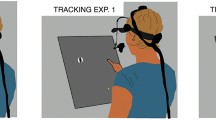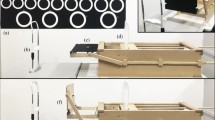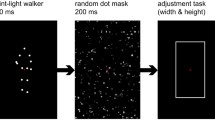Abstract
Many interceptive actions involve interactions with objects that are familiar to the observer and have known sizes. Two experiments investigated how known size influences observers’ perception of time-to-contact (T c). Participants made T c judgements of objects that were either ambiguously sized, standard-size in identity/familiarity, or off-size in identity/familiarity, and simulated as approaching on linear trajectories (Experiment 1), or linear versus parabolic trajectories (Experiment 2). In Experiment 1, T c judgements were influenced by the size of the object in the three object identity/familiarity conditions; the greatest size effect occurred in the off-size condition compared to the ambiguous size and standard-size conditions. The results of Experiment 2 replicated these results and found that size effects were not reduced with displays simulating parabolic trajectories, that is, displays simulating ecologically valid free-falling objects. Taken together, the finding that T c judgements are influenced by object identity/familiarity does not provide support for the tau hypothesis, nor the hypothesis that T c judgements are based solely on optic expansion rates. However, the results do provide support for the proposition that T c judgements are based on a combination of rate of retinal image expansion and object identity/familiarity information, the latter information requiring observers to have prior experience with, or knowledge about, the objects.








Similar content being viewed by others
References
Abernethy B, Gill DP, Parks SL, Packer ST (2001) Expertise and the perception of kinematic and situational probability information. Perception 30:233–252
Battaglia P, Schrater P, Kersten D (2005) Auxiliary object knowledge influences visually guided interception behavior. ACM Int Conf Proc Ser 95:145–152
Brouwer AM, López-Moliner J, Brenner E, Smeets JBJ (2006) Determining whether a ball will land behind or in front of you: not just a combination of expansion and angular velocity. Vis Res 46:382–391
Cavallo V, Laurent M (1988) Visual information and skill level in time-to-collision estimation. Perception 17:623–632
DeLucia PR (1991) Pictorial and motion-based information for depth perception. J Exp Psychol Hum Percept Performan 17:738–748
DeLucia PR (2004) Time-to-contact judgments of an approaching object that is partially concealed by and occluder. J Exp Psychol Hum Percept Performan 30:287–304
DeLucia PR (2005) Does binocular disparity or familiar size override effects of relative size on judgments of time to contact? The Q J Exp Psychol A 58:865–886
DeLucia PR, Warren R (1994) Pictorial and motion-based depth information during active control of self-motion: Size-arrival effects on collision avoidance. J Exp Psychol Hum Percept Performan 20:783–798
DeLucia PR, Kaiser MK, Bush JM, Meyer LE, Sweet BT (2003) Information integration in judgements of time to contact. Q J Exp Psychol Hum Exp Psychol 56A:1165–1189
Distler HK, Gegenfurtner KR, van Veen HAHC, Hawken MJ (2000) Velocity constancy in a virtual reality environment. Perception 29:1423–1435
Epstein W (1965) Nonrelational judgments of size and distance. Am J Psychol 78:120–123
Gibson EJ (1969) Principles of Perceptual Learning and Development. Meredith Corporation, New York
Gibson JJ (1979) The ecological approach to visual perception. Houghton Mifflin, Boston, MA
Gogel WC, DaSilva JA (1987) Familiar size and the theory of off-sized perception. Percept Psychophys 41:318–328
Gray R (2002) Behaviour of college baseball players in a virtual batting task. J Exp Psychol Hum Percept Performan 28:1131–1148
Gray R, Regan D (1999) Do monocular time-to-collision estimates necessarily involve perceived distance? Perception 28:1257–1264
Haber RN, Levin CA (2001) The independence of size perception and distance perception. Percept Psychophys 63:1140–1152
Hershenson M (1992) Size-distance invariance: kinetic invariance is different from static invariance. Percept Psychophys 51:541–548
Hershenson M, Samuels SM (1999) An airplane illusion: apparent velocity determined by apparent distance. Perception 28:433–436
Indovina I, Maffei V, Bosco G, Zago M, Macaluso E, Lacquaniti F (2005) Representation of visual gravitational motion in the human vestibular cortex. Science 308:416–419
Jacobs DM, Michaels CF (2006) Lateral interception I: operative optical variables, attunement, and calibration. J Exp Psychol Hum Percept Performan 32:443–458
Lee DN (1976) A theory of visual control of braking based on information about time-to-collision. Perception 5:437–459
Lee DN, Reddish PE (1981) Plummeting gannets: a paradigm of ecological optics. Nature 293:293–294
López-Moliner J, Field DT, Wann JP (2007) Interceptive timing: Prior knowledge matters. J Vis 7:1–8
McLeod RW, Ross HE (1983) Optic-flow and cognitive factors in time-to-collision estimates. Perception 12:417–423
Michaels CF, Zeinstra EB, Oudejans RRD (2001) Information and action in punching a falling ball. Q J Exp Psychol 54A:69–93
Miller WL, Maffei V, Bosco G, Iosa M, Zago M, Macaluso E, Lacquaniti F (2008) Vestibular nuclei and cerebellum put visual gravitational motion in context. J Neurophysiol 99:1969–1982
Peper L, Bootsma RJ, Mestre DR, Bakker FC (1994) Catching balls: how to get the hand into the right place at the right time. J Exp Psychol Hum Percept Performan 20:591–612
Predebon J (1992) The role of instructions and familiar size in absolute judgments of size and distance. Percept Psychophys 51:344–354
Rushton SK, Duke PA (2009) Observers cannot accurately estimate the speed of an approaching object in flight. Vision Research 49:1919–1928
Savelsbergh GJP, Whiting HTA, Bootsma RJ (1991) Grasping tau. J Exp Psychol Hum Percept Performan 17:315–322
Savelsbergh GJP, Whiting HTA, Burden AM, Bartlett RM (1992) The role of predictive visual temporal information in the coordination of muscle activity in catching. Experimental Brain Research 89:223–228
Saxberg BVH (1987) Projected free fall trajectories: I. Theory and simulation. Biol Cybern 56:159–175
Schiff W, Detwiler ML (1979) Information used in judging impending collision. Perception 8:647–658
Smith MRH, Flach JM, Dittman SM, Stanard T (2001) Monocular optical constraints on collision control. J Exp Psychol Hum Percept Performan 27:395–410
Stewart N (2006a) Millisecond accuracy video display using opengl under linux. Behav Res Methods 38:142–145
Stewart N (2006b) A PC parallel port button box provides millisecond accuracy under linux. Behav Res Methods 38:170–173
Todd JT (1981) Visual information about moving objects. J Exp Psychol Hum Percept Performan 7:795–810
Tresilian JR (1991) Emperical and theoretical issues in the perception of time-to-contact. J Exp Psychol Hum Percept Performan 17:865–876
Tresilian JR (1995) Perceptual and cognitive processes in time-to-contact estimation: analysis of prediction-motion and relative judgment tasks. Perception & Psychophysics 57:231–245
van der Kamp J, Savelsbergh G, Smeets J (1997) Multiple information sources guiding the timing of interceptive actions. Human Movement Science 16:787–822
Wann JP (1996) Anticipating arrival: is the tau margin a specious theory? J Exp Psychol Hum Percept Performan 22:1031–1048
Watson JS, Banks MS, von Hofsten C, Royden CS (1992) Gravity as a monocular cue for perception of absolute distance and/or size. Perception 21:69–76
Yakimoff M, Mateeff S, Ehrenstein W, Hohnsbein J (1993) Motion extrapolation performance: A linear model approach. Hum Factors 35:501–510
Zago M, Bosco G, Maffei V, Iosa M, Ivanenko YP, Lacquaniti F (2004) Internal models of target motion: expected dynamics overrides measured kinematics in timing manual interceptions. Journal of Neurophysiology 91:1620–1634
Zago M, McIntyre J, Senot P, Lacquaniti F (2009) Visuo-motor coordination and internal models for object interception. Exp Brain Res 192:571–604
Author information
Authors and Affiliations
Corresponding author
Rights and permissions
About this article
Cite this article
Hosking, S.G., Crassini, B. The effects of familiar size and object trajectories on time-to-contact judgements. Exp Brain Res 203, 541–552 (2010). https://doi.org/10.1007/s00221-010-2258-7
Received:
Accepted:
Published:
Issue Date:
DOI: https://doi.org/10.1007/s00221-010-2258-7




